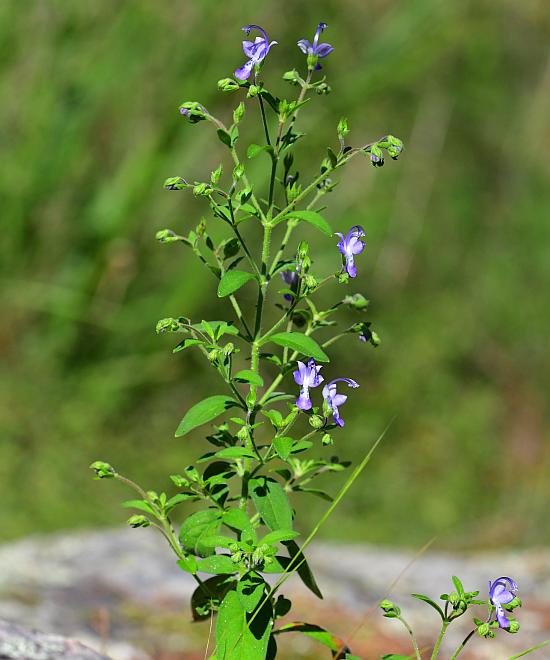Trichostema dichotomum L.
Blue Curls

Native
CC = 6
CW = 5
MOC = 21
© SRTurner
Trichostema dichotomum L.Blue Curls | |
 |
Native CC = 6 CW = 5 MOC = 21 |
© SRTurner |
|
Family - Lamiaceae Habit - Annual forb with slender taproot. Stem - Ascending to erect, to 50 cm, slender, bluntly 4-angled, densely pubescent with gland-tipped and nonglandular hairs.
Leaves - Opposite, simple, entire, petiolate or the uppermost leaves sometimes sessile. Blades 1.5-6.0 cm long, mostly 5-25 mm wide, oblong to elliptic or ovate, angled or tapered at the base, bluntly or sharply pointed at the tip, minutely hairy, the surfaces moderately pubescent with minute, curved, nonglandular hairs, the undersurface also with inconspicuous sessile glands, the venation of a midvein and more or less evident, pinnately branching, secondary veins.
Inflorescence - Inflorescences appearing terminal and axillary, usually as open, irregularly branched panicles with leaflike bracts that are smaller than the foliage leaves, the flowers paired at the nodes or in pairs of small, loose clusters or panicles, each with 3-7 flowers. Flowers becoming inverted as the fruits mature.
Flowers - Calyces 3-5 mm long at flowering, becoming enlarged to 5-9 mm at fruiting, zygomorphic, 2-lipped, the upper lip with 3 triangular lobes, about 3 times as long as the lower lip, which has 2 narrowly triangular lobes, the outer surface densely pubescent with a mixture of minute, gland-tipped and longer, nonglandular hairs, also with usually conspicuous sessile glands. Corollas 4-12 mm long, strongly zygomorphic, the tube funnelform, expanded in the throat, the upper lip with 4, shorter, similar, spreading to slightly inward-arched lobes, these blue to purplish blue, the lower lip with 1, much longer, spreading lobe, this abruptly spreading, usually white below the blue to purplish blue tip, the white portion spotted or mottled with blue to purplish blue. Stamens strongly exserted, the filaments 6-16 mm long, strongly arched downward, the anthers dark blue.
Fruits - Dry schizocarps, separating into usually 4 nutlets, these 1.5-3.0 mm long, yellowish brown to dark brown, glabrous.
Flowering - August - October. Habitat - Glades, openings of dry forests, bluff tops, sand prairies, usually on acidic substrate. Origin - Native to the U.S. Lookalikes - Trichostema setaceum Other info. - This distinctive plant occurs in glades in the eastern half of Missouri's Ozarks. Its larger distribution extends from Missouri southward and northeastward, into the New England states and Canada. It is not massively showy, but a close look will reveal the beautiful detail in the flowers. The "curls" of the common name refers to the long, arching filaments. Although this is feature is highly characteristic, it is not unique to this species. A lookalike is T. setaceum, which has very similar flowers but leaves which are much narrower and lack evident lateral venation. Photographs taken at Umstead State Park, NC., 9-22-02, and off Lee Rd. 54, Auburn, AL., 8-30-05 (DETenaglia); also at Don Robinson State Park, Jefferson County, MO, 08-23-2010 and 9-2-2021, and LaBarque Creek Conservation Area, Jefferson County, MO, 09-09-2012, 09-24-2014, and 08-27-2018 (SRTurner). |